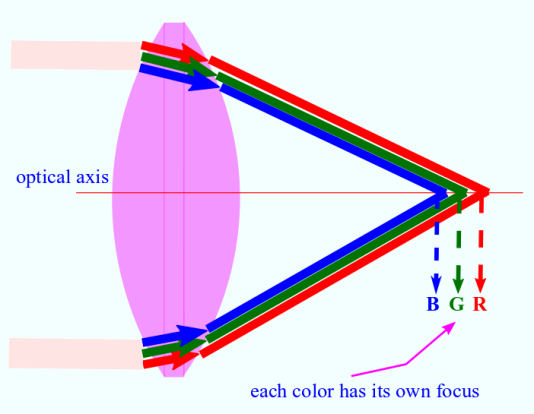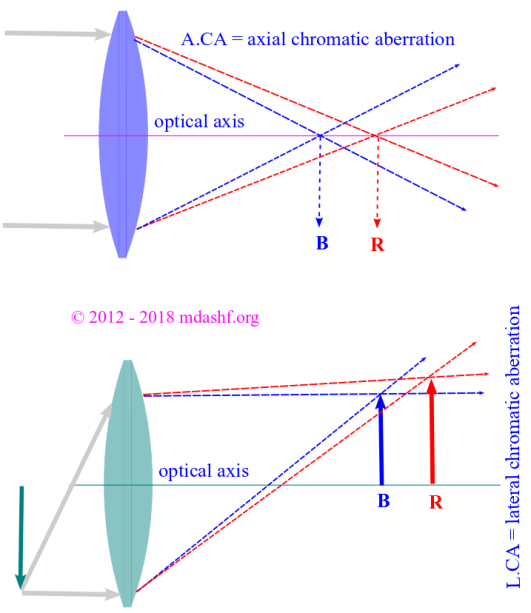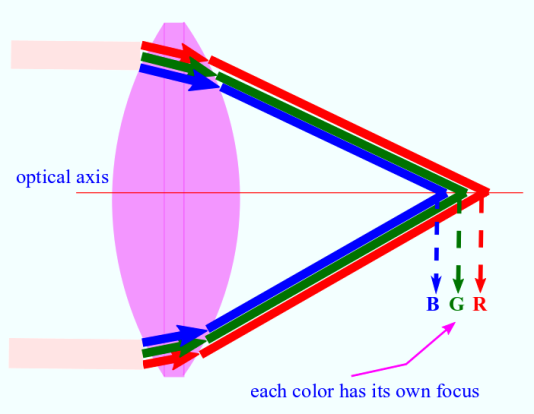Optics series, lecture — I
Lecture delivered on 24 – 1 – 2017
( all optics series lectures ) Go to other available optics lectures
“Optical aberrations”
This lecture has been delivered in one of the honors class that I am teaching this semester. You will do really well to read the following article although this is not intended as a honors lecture.
( Optical path and Fermat’s principle ) read Fermat’s principle and optical path
Optical systems are studied under two assumptions:
- a. Object points
- object points do not lie far away from the axis of the optical system.
- b. Rays
- rays taking part in image formation make a small angle with the axis of the optical system.
The domain of optics where the above two assumptions are valid is called as Paraxial optics. Paraxial systems are highly idealized and in reality they do not perfectly represent the situation. The consequential errors in image reconstruction are known as aberrations.
The paraxial assumption can be represented by truncating at the first term ( i.e. first order ) of the polynomial expansion of the sine function by the Maclaurin series.
First order: and Maclaurin series:
.
If instead the second term in the Maclaurin series is retained and higher order terms are truncated then we say it’s a 3rd order theory — as opposed to the 1st order theory ( which we also called the paraxial optical assumption ).
If a single wavelength source of light is considered along with a 3rd order theory, the deviations from 1st order theory results thus obtained are summed up as primary or monochromatic aberrations. These aberrations are also known as Seidel aberrations in accordance with the name of the scientist Ludwig Von Seidel who studied them.
The primary aberrations are broadly categorized into 5 types;
- a. Spherical aberration
- spherical aberration occurs due to different location of the ray wrt the optical axis, producing multiple focuses and as a result blurring the image. The object has to be axial ( on optical axis i.e. ) but the rays could be both axial ( called paraxial ) or off-axis ( called marginal ). The off-axis rays in case of axial objects produce larger spherical aberration
- b. Coma
- coma refers to a comet like image production when objects are no more on the optic axis but ‘slightly’ off-axis
- c. Astigmatism
- astigmatism refers to a kind of aberration caused when objects points are ‘considerably’ off-axis
- d. Petzval field curvature
- when objects points are ‘considerably‘ off-axis the focal points are on two different surfaces causing astigmatism, when the focal points coincide astigmatism is zero but there still is some curvature on the image surface, this is referred to as curvature of field
- e. Distortion
- distortion is caused due to non-uniform magnification
The first three type of aberrations lead to a deterioration in the quality of the image making them unclear. The last two types cause deforming of the shape or size of the images.
The primary aberrations can be minimized by manipulating the various physical attributes of the optical system, such as; power, shape, thickness, material and separation of lenses.
There is yet another type of aberration which results due to the fact that light consists of various colors or wavelengths and refractive indices of the media, size ( and therefore magnification ). As a result the location of the images depend upon color, frequency or wavelength of individual light components.
This particular type of aberration is called as chromatic aberration. This results in the coloring and overlaying of differently colored images. Chromatic aberration is simpler to understand than monochromatic aberration and we will discuss this before the latter.
Chromatic aberration
When light from a poly-chromatic light source is incident on a lens the focal length of the lens is a function of wavelength λ, where the focal length f ( λ ) increases with λ. Thus for a positive lens ( i.e. converging or convex ) the focus for the blue color is nearer to the lens and the focus for the red color is farther than that for the blue color. This result is opposite for the negative lens ( i.e. diverging or concave ).

The axial separation between focus for blue and focus for red color of light is known as axial chromatic aberration ( abbreviated as A.CA ). It’s also known as axial color. Similarly the vertical separation between image points for far off axis object points for blue and red color light is known as lateral chromatic aberration ( abbreviated as L.CA ). This is also known as lateral color. See the two images below.
Remember that L.CA is positive for convex lens and negative for concave lens. Lets depict these two parameters by a suitable geometric diagram.

The human eyes can carry substantial amount of chromatic aberration. A purple dot close to eye would appear blue at the center surrounded by red and farther away it would appear red surrounded by blue.
Lets derive chromatic aberration in a thin lens for blue and red light.
Derivation
We know the thin lens formula is given as: .
When n is changed by δn, due to change in λ, we can get the corresponding change in f by differentiating: .
So we have: and for blue and red light:
.
Remember that n is the regular value of refractive index which is thus the average value from all possible values. We will soon see how its related to red and blue light values.
The chromatic aberrations can be minimized by an arrangement called achromatic doublet. It’s so named because there are two lenses which are combined to nullify the color aberration.
Achromatic doublets
Chromatic aberration can be reduced. By making arrangement of a positive and a negative lens, necessarily of different materials. CA can also be reduced by making arrangement of two positive lenses of same material. Lets study the first case first.
1. Achromatic doublet
Lets denote the second lens by the primed notation so that unprimed denotes the first lens.
So we will have symbols like: n’b, n’y, n’r which will denote for the second lens, the refractive indices, for the blue, yellow and red color of light respectively. When we combine the first lens and the second, their focal length will be denoted by capital F.
All of the symbols are thus self-evident, depending on whether a subscript ( for color of light ), superscript ( for second lens ) or capital ( for combination of first lens and second lens ) is used.
Now lets write down the inverse of the focal length of the combination of first lens and second lens, for blue light. Its simply the addition of the inverse of the focal length of first lens and second lens, for blue light; so,
Here we have used the fact that the focal lengths and refractive indices without reference to any color ( blue, yellow, red ) are mean refractive indices and corresponding focal lengths, the mean color is quite close to yellow color.
In other words: and
also
and
. You can also guess easily that:
.
So for the combination of lenses 1 and 2 the aberration due to color will be nullified if their blue and red focal lengths will be same.
That means; ,
and
.
The ω and ω’ are called as dispersive power of the lenses. Notice that ω and ω’ are always positive hence f and f’ must be of opposite sign for the chromatic aberration to be null.
That means while one lens is convex the other must be concave. Also note that if two lenses are of same material ( i.e. ω = ω’ ) then it leads to infinite focal length. So the lens material should be different as well.
This leads us to study the possibility of minimizing the color aberration in case 2 that we set out earlier.
2. Separated doublet
Let us consider two lenses of focal lengths f and f’ placed apart a distance of t. The focal length of the combination is given as; where
and
.
As earlier δf and δn are changes in refractive index and focal lengths due to same in wavelength, λ. Lets now differentiate the focal length of the combination of a separated doublet.
We have; so,
.
This leads to; . For the doublet to have same focal length for blue and red light:
or
.
If the same material is used: .
This is the attribute of the Huygens’s eyepiece. Lets wrap up this with a numerical, when time has it we will augment this discussion to include the primary aberrations we discussed at the beginning.
( The primary aberration lecture ) Read a detailed discourse on primary aberration
Problem
An achromatic doublet of focal length 20 cm is to be made by placing a convex lens of borosilicate crown glass in contact with a diverging lens of dense flint glass. Calculate the focal length of each lens ( primed = flint ) if nr = 1.51462, nb = 1.52264, n'r = 1.61216 and n'b = 1.62901. Hint: Find the mean refractive index for lens 1 and lens 2. Find the dispersive power for each lens ω and ω'. Now use the fact that inverse of focal length of combination of lens is inverse of focal lengths of each lens, added together. Find f, f'.

Leave a comment